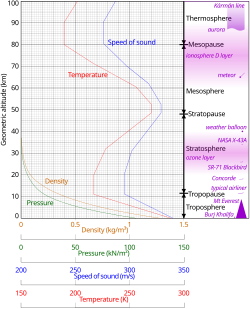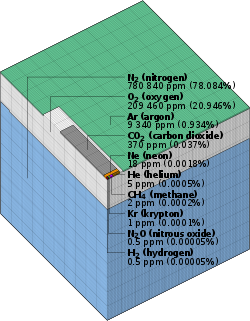TheU.S. Standard Atmosphereis astatic atmospheric modelof how thepressure,temperature,density,andviscosityof theEarth's atmospherechange over a wide range ofaltitudesorelevations.The model, based on an existing international standard, was first published in 1958 by the U.S. Committee on Extension to the Standard Atmosphere, and was updated in 1962, 1966, and 1976. It is largely consistent in methodology with theInternational Standard Atmosphere,differing mainly in the assumed temperature distribution at higher altitudes.


Methodology
editThe USSAmathematical modeldivides the atmosphere into layers with an assumed linear distribution ofabsolute temperatureTagainstgeopotential altitudeh.[2]The other two values (pressurePand densityρ) are computed bysimultaneously solving the equationsresulting from:
- thevertical pressure variation,which relates pressure, density and geopotential altitude (using a standard pressure of 101,325 pascals (14.696 psi) atmean sea levelas aboundary condition):
- ,and
- theideal gas lawinmolarform, which relates pressure, density, and temperature:
at each geopotential altitude, wheregis thestandard acceleration of gravity,andRspecificis thespecific gas constantfor dry air.
Air density must be calculated in order to solve for the pressure, and is used in calculatingdynamic pressurefor moving vehicles.Dynamic viscosityis an empirical function of temperature, andkinematic viscosityis calculated by dividing dynamic viscosity by the density.
Thus the standard consists of a tabulation of values at various altitudes, plus some formulas by which those values were derived.
To allow modelingconditions below mean sea level,the troposphere is actually extended to −2,000 feet (−610 m), where the temperature is 66.1 °F (18.9 °C), pressure is 15.79 pounds per square inch (108,900 Pa), and density is 0.08106 pounds per cubic foot (1.2985 kg/m3).
1962 version
editThe basic assumptions made for the 1962 version were:[3]
- air is a clean, dry,perfect gasmixture (cp/cv= 1.40)
- molecular weightto 90 km of 28.9644 (C-12 scale)
- principal sea-level constituents are assumed to be (in mole percent):
- assigned mean conditions atsea levelare as follows:
TheFederal Aviation RegulationsdefineStandard Atmospherein14 CFR1.1by reference to the U.S. Standard Atmosphere, 1962 (Geopotential altitude tables).
1976 version
editThis is the most recent version and differs from previous versions only above 51 km:
| Subscriptb | Geopotential height above MSL[4] |
Static pressure | Standard temperature (K) |
Temperature lapse rate | |||
|---|---|---|---|---|---|---|---|
| (m) | (ft) | (Pa) | (inHg) | (K/m) | (K/ft) | ||
| 0 | 0 | 0 | 101325 | 29.92126 | 288.15 | −0.0065 | −0.001981 |
| 1 | 11,000 | 36,089 | 22632.1 | 6.683245 | 216.65 | 0.0 | 0.0 |
| 2 | 20,000 | 65,617 | 5474.89 | 1.616734 | 216.65 | 0.001 | 0.0003048 |
| 3 | 32,000 | 104,987 | 868.019 | 0.2563258 | 228.65 | 0.0028 | 0.0008534 |
| 4 | 47,000 | 154,199 | 110.906 | 0.0327506 | 270.65 | 0.0 | 0.0 |
| 5 | 51,000 | 167,323 | 66.9389 | 0.01976704 | 270.65 | −0.0028 | −0.0008534 |
| 6 | 71,000 | 232,940 | 3.95642 | 0.00116833 | 214.65 | −0.002 | −0.0006096 |
| 7 | 84,852 | 278,385 | 186.946 | ||||
See also
editReferences
edit- ^Geometric altitude vs. temperature, pressure, density, and the speed of sound derived from the 1962 U.S. Standard Atmosphere.
- ^Gyatt, Graham (2006-01-14):"The Standard Atmosphere".A mathematical model of the 1976 U.S. Standard Atmosphere.
- ^Tuve, George Lewis; Bolz, Ray E. (1973).CRC handbook of tables for applied engineering science.Boca Raton:CRC Press.ISBN0-8493-0252-8.
- ^U.S. Standard Atmosphere, 1962, U.S. Government Printing Office, Washington, D.C., 1962,https:// ngdc.noaa.gov/stp/space-weather/online-publications/miscellaneous/us-standard-atmosphere-1976/us-standard-atmosphere_st76-1562_noaa.pdf
Documents
edit- U.S. Extension to the ICAO Standard Atmosphere, U.S. Government Printing Office, Washington, D.C., 1958.
- U.S. Standard Atmosphere, 1962, U.S. Government Printing Office, Washington, D.C., 1962.[1]
- U.S. Standard Atmosphere Supplements, 1966, U.S. Government Printing Office, Washington, D.C., 1966.
- U.S. Standard Atmosphere,1976, U.S. Government Printing Office, Washington, D.C., 1976 (Linked file is 17 MB).